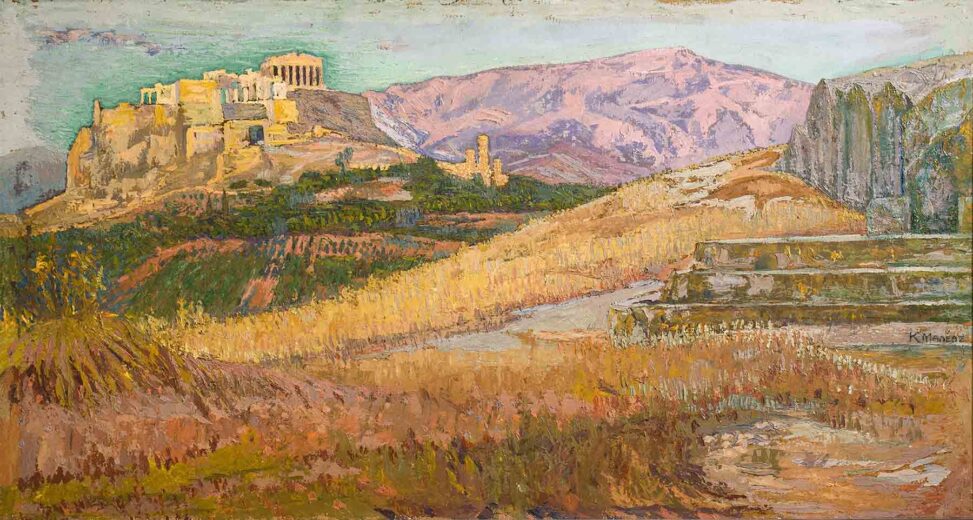Konstantinos Maleas | Κωνσταντίνος Μαλέας
Acropolis View from Pnyka | Η Ακρόπολη από την Πνύκα
1914 – 1917
Oil painting on cardboard, 54x 99 cm | Ελαιογραφία σε χαρτόνι, 54 x 99 εκ.
Exhibited at the Rhodes Museum of Contemporary Art. | Εκτίθεται στο Μουσείο Νεοελληνικής Τέχνης Ρόδου
The painting depicts the sacred rock on the left with the Parthenon at its highest point, while Pnyka can be seen on the right. The composition is characterized by the typical vegetation of the dry Attic landscape. Influences from post-impressionism can be seen in the work. Kostas Maleas (1879-1928) has created different levels for the organization of the subject, which are defined by the movement of the brush and the pure color that it deposits on the painted surface, while the color palette the painter moves in tones of yellow, green, brown with intermediate shades. Maleas was extensively involved in the depiction of the Parthenon. In this work, he has placed the main subject in the background of the painting but at the highest point, in order to draw the viewer’s attention, while Pnyka is difficult to distinguish on the right, despite being closer to the viewer, due to the color uniformity of the rocks and the environment. In any case, the painter’s interest is not in the realistic depiction of the subject but in its emotional capture through the power of pure colors. SOURCE: Μουσείο Νεοελληνικής Τέχνης Ρόδου
Ο πίνακας εικονίζει αριστερά τον ιερό βράχο με τον Παρθενώνα στο ψηλότερο σημείο του, ενώ δεξιά φαίνεται η Πνύκα. Η σύνθεση χαρακτηρίζεται από την τυπική βλάστηση του ξηρού αττικού τοπίου. Στο έργο διακρίνονται επιδράσεις από τον μεταϊμπρεσιονισμό. Ο Κώστας Μαλέας (1879-1928) έχει δημιουργήσει διαφορετικά επίπεδα για την οργάνωση του θέματος, τα οποία ορίζονται από την κίνηση του πινέλου και του καθαρού χρώματος που αυτό εναποθέτει στη ζωγραφική επιφάνεια, ενώ η χρωματική παλέτα ο ζωγράφος κινείται σε τόνους κίτρινους, πράσινους, καφέ με ενδιάμεσες αποχρώσεις. Ο Μαλέας ασχολήθηκε εκτεταμένα με την αποτύπωση του Παρθενώνα. Στο έργο αυτό έχει τοποθετήσει το κυρίως θέμα στο βάθος του πίνακα αλλά στο ψηλότερο σημείο, προκειμένου να τραβά την προσοχή του θεατή, ενώ η Πνύκα διακρίνεται με δυσκολία στα δεξιά, παρ’ όλο που είναι πιο κοντά στον θεατή, λόγω της χρωματικής ομοιομορφίας των βράχων και του περιβάλλοντος. Σε κάθε περίπτωση, το ενδιαφέρον του ζωγράφου στρέφεται όχι στη ρεαλιστική απεικόνιση του θέματος αλλά στη συναισθηματική αποτύπωσή του μέσω της δύναμης των καθαρών χρωμάτων. ΠΗΓΗ: Rhodes Museum of Contemporary Art




